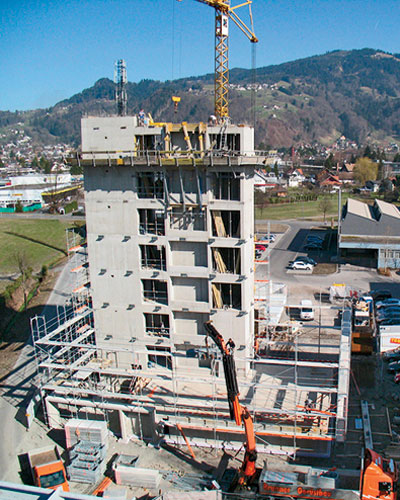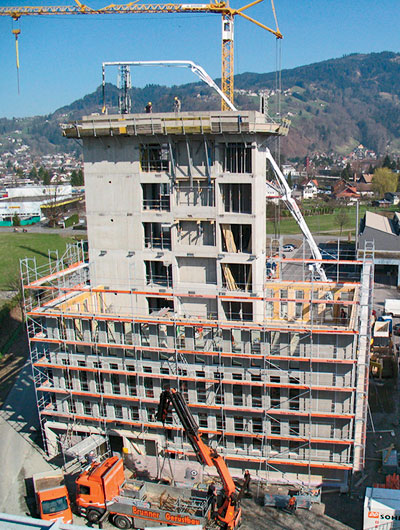Wood's New Wave
The design team calculated that the total amount of wood specified for the project, including the atrium roof, sequesters about 230 metric tons of carbon dioxide. And according to Green, both LSL and LVL manufacturers are now open to providing customers with larger-format product for larger and taller projects, and for longer spans, based on the discussions generated by this project.
Tall-Building Systems
In addition to testing numerous panel options in smaller structures, Green and Karsh have proposed a universal system of constructing tall buildings with wood panels that they term FFTT, or Finding the Forest Through the Trees. They outline structural configurations, details, and analysis for four prototypical buildings in the report Tall Wood. All have below-grade concrete foundations and rely on mass-timber panels for floors and roof. The four range from a 12-story building with mass-timber panels at the central core and glulam columns at the curtain wall to a 30-story building with mass-timber panels at central core and walls plus steel beams at the exterior. According to the study, these structures “can meet relevant structural design criteria and fire and life safety needs, and do so within cost competitive marketplace conditions.”
 |
 |
 |
 |
|
Photos © CRRE The eight-story LCT One building in Dornbirn, Austria, showcases the innovative timber-and-concrete hybrid construction system developed by CREE. Its aluminum shell disguises the timber frame. |
While Green and his team have been focusing on what he calls a “dry system” for tall structures, in which no concrete is used, the Austrian-based firm CREE has developed a hybrid timber system for up to 30 stories that it calls LifeCycle Tower, or LCT.
The basic components of an LCT building include a central core, which can be constructed of either concrete or wood panels, depending on regional codes; glulam double columns at the exterior walls; floor panels composed of reinforced-concrete topping supported by two glulam beams that run lengthwise on either side of the panel and span between the core and double columns for a maximum of 30 feet; and wood-framed wall panels that span the double columns to form the exterior facade. Building services are easily accessible in the space between the glulam beams and below the concrete topping.
Because all the elements are modular and come to the site already preinstalled with interconnecting pins and holes, an LCT building can be erected very quickly. CREE's Tahan reports that the company assembled all floors and walls of its first building in 2012—the eight-story LCT One in Dornbirn, Austria, which serves as CREE's headquarters—in a mere eight days. And, despite the speed, the accuracy of the methodology allowed the building to meet rigorous passive-house standards for infiltration rates and other energy-performance criteria. Another advantage of building modularly is that the structure can be disassembled and the components reused for other buildings in the future.
Although it has yet to construct a 30-story building with LCT, CREE estimates that such a structure would use about 5,000 cubic meters of timber. Underscoring the value of using building components made by the sun, Tahan reports that, according to calculations made by Minneapolis-based sustainability consultant Dovetail Partners, it would take a mere 3.5 minutes of growth on all the timberland in the United States to generate that much wood.
Looking Ahead
Proponents of large-scale wood construction cite outdated building codes as one of the biggest barriers to this new approach. Most codes limit the height of wood-constructed buildings out of concerns about fire. But these codes were written primarily with stick-frame construction in mind; that functions very differently than mass-timber construction in a fire. While thin wood members will burn quickly, the exterior of massive timber will burn for a bit but then create a layer of char that insulates the remaining interior wood from damage. Furthermore, many of today's fire codes were written decades ago, before fire sprinklers and computer-controlled fire-monitoring systems were developed. “Those advances change how we look at fire,” notes Karsh. Practitioners working on large-scale wood projects in Canada indicate that they must currently provide equivalency reports to satisfy the code, but Karsh believes that will likely change with the next iteration of Canada's National Building Code, scheduled for 2015.
Another barrier, at least in North America, is a shortage of manufacturers. According to Podesto of Woodworks, only three companies make structural-grade CLT in Canada, and none in the United States.
But Karsh is not deterred, noting that it took decades for steel and concrete to evolve into the modern systems we use today. “Modern wood construction is 100 to 120 years behind. Only in the last 20 years have we developed it into a truly modern construction material.” He believes the product will become more sustainable in the years ahead. “The idea of building high-rise timber may seem crazy now, but it won't in five to 10 years.”








